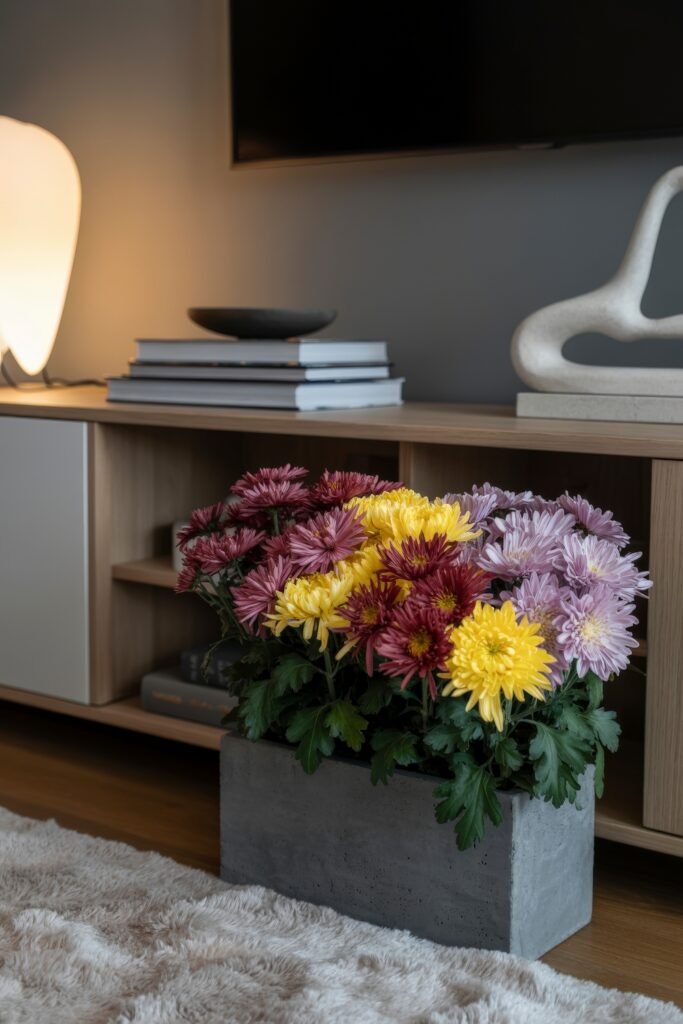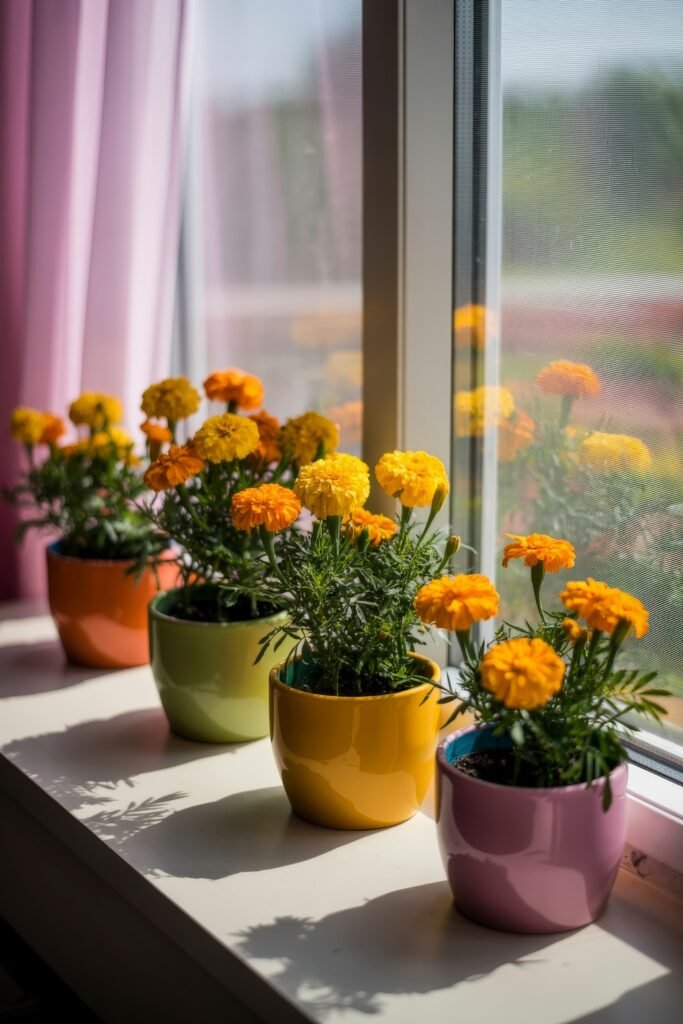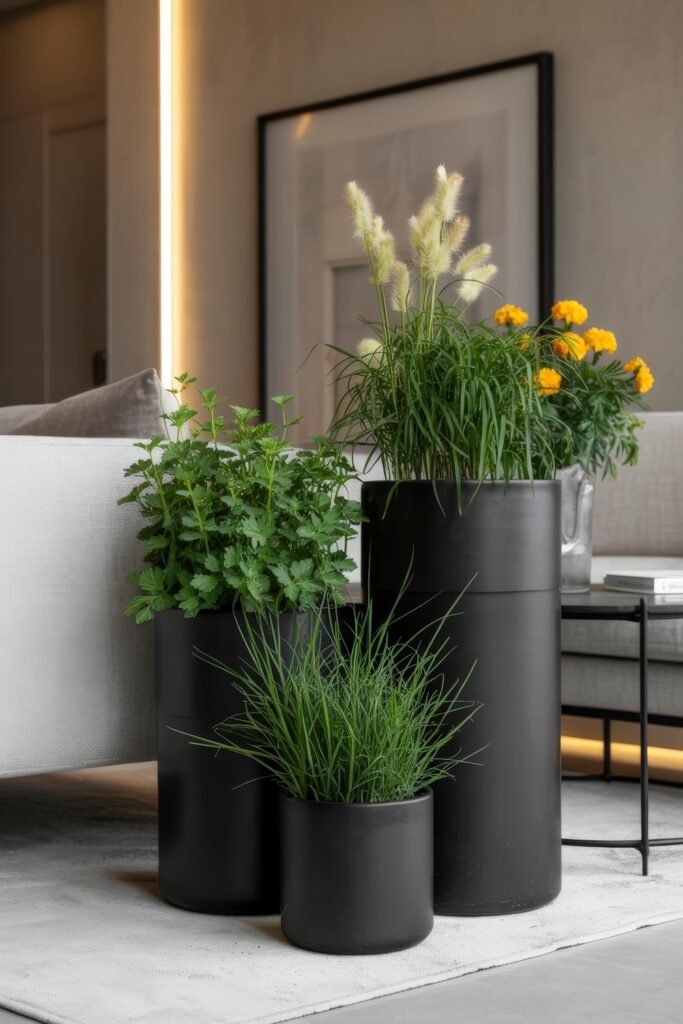Best indoor plants to repel insects might be the simplest décor trick you haven’t tried—think leafy centerpieces that smell amazing and make bugs bolt. If your apartment feels like a gnat-and-mosquito lounge, trading chemical sprays for living green guards is fresher, budget-friendlier, and way more Pinterest-pretty.
- First, you’ll see how a tiny windowsill of basil and rosemary scrambles kitchen flies and gnats before they spot your snacks.
- Next, we’ll tour a lavender-and-catnip bedroom that lulls you to sleep while telling mosquitoes to buzz off.
- Finally, watch bright mums and marigolds pull double duty—color bomb plus stealth shield against ants and buzzing flies.
Ready to meet these herb heroes? Let’s dig into your kitchen windowsill first.
Freshen kitchen windows with aromatic herb defenders
A tiny windowsill can work harder than you think. Park a few herbs there and you’ll get fresh smells, quick flavor boosts, and a sneaky bug shield all at once. We’ll hang out with two dream teams below. First up: basil plus rosemary, the duo that tosses flies and gnats out the door. Then peppermint joins the party to block ant traffic on your counters. Let’s dive in, coffee in hand, and see how these green buddies keep your kitchen chill, tasty, and pest-free.
When you live in an apartment, every inch counts. Herbs pack big power into small pots, so no bulky gadgets needed. You can cook, sniff, and wave goodbye to bugs without leaving your cozy space. Even better, the plants pull double duty as décor, making your kitchen look like a sunny café. Tiny space, huge win.
Basil and rosemary confuse flies and gnats
Flies love a ripe banana and will circle it like sharks. Basil and rosemary throw off their radar. Their strong oils make the kitchen smell like pizza night while bugs lose the scent trail. They’re happy in the same pot, so you only need one spot of sunshine.

How it sends bugs packing
Basil packs clove-like oils. Rosemary brings sharp, piney scents. Together they cloud the air with smells that scramble fly and gnat signals. The insects show up, get confused, and zip away to bother someone else. You get to keep your fruit bowl in peace.
Make it look good
Let basil spill over the rim, almost like leafy waterfalls. Rosemary stands tall in the middle like a tiny tree. Use a terracotta pot for a warm café vibe. The mix of shapes and textures turns one pot into instant window art. Snap a pic; your friends will ask how you made “herb hair.”
Best spot in your place
Keep the pot by the sink or stove. Each time you wash dishes or stir sauce, you brush the leaves. That light touch bursts more scent into the air. Bugs dislike surprise scent bombs, so they steer clear. Your dinner stays private.
One shared pot, two herbs, zero drama. You’ll season pasta, smell summer, and shoo flies without lifting a spray can. That’s smart apartment living.
Quick tip: Pinch a few basil leaves every week. The plant grows bushier, the scent grows stronger, and the bugs grow sadder.
Peppermint trails deter ants on countertops
Ants march like tiny soldiers and follow scent maps you can’t even see. Peppermint is their GPS jammer. Its cool, sharp smell says, “Road closed, turn around.” Plus, who doesn’t love that fresh candy-cane whiff while making coffee?


How it sends bugs packing
Peppermint’s menthol is loud to an ant’s nose. It blurs the pheromone lines that guide the colony. Scouts get lost, report back, and the whole team stays outside. No crumbs for them today.
Make it look good
Let stems tumble from a retro tea tin or hang in a small macramé sling. The vines act like playful fringe against plain tiles. Guests may reach out just to feel the leaves, which spreads more minty smell. Style and function in one swoop.
Best spot in your place
Place cuttings right on the ant highway—behind the toaster, along the windowsill crack. Each whiff is a roadblock. Water lightly so soil stays damp but not soggy; peppermint hates wet feet. Happy plant, unhappy ants.
Think of peppermint as living border patrol. One sniff and ants file a detour request. Your counters stay crumb-free, and your kitchen smells like fresh gum all day.
How to: Trim extra stems, dunk them in water, and set near the trash can. They’ll root, smell great, and guard another hotspot for free.
Elevate bedroom calm with soothing scented bloom guards
Your bedroom should feel like a spa minus the price tag. Soft colors, gentle smells, and zero buzzing at midnight—that’s the dream. Two plants pull it off: lavender calms you while shooing moths and spiders, and catnip keeps sneaky mosquitoes from nibbling you while you sleep. Both look cute and ask little in return. Ready to reclaim dreamland?
Apartments can trap stale air, but these blooms flip that script. They freshen the room and match cozy décor vibes. You’ll fall asleep faster, wake up bite-free, and maybe even skip the plug-in fragrance thingy forever. Let the night shift begin.
Lavender shrubs hush moths and spiders
Lavender isn’t just for grandma’s closet. A small pot on your dresser brings beach-vacation scent to bedtime. The purple spikes look fancy without trying, and most bugs would rather leave than sniff it.


How it sends bugs packing
Lavender releases sweet yet punchy oils. Moths, flies, and some spiders hate those notes. They sniff, cringe, and crawl away to safer ground. Your sweaters and pillow forts stay untouched.
Make it look good
Pick a dwarf variety in a low white bowl. Silvery leaves match any bedding—neutrals, patterns, you name it. The purple flowers pop like tiny fireworks at eye level. Spa feels? Nailed it.
Best spot in your place
Set the bowl on a sunny sill or dresser. Afternoon sun warms the oils, so scent fills the room by night. Give stems a gentle brush before lights out. Instant aroma cloud equals instant calm.
One compact lavender offers aromatherapy and a “no-vacancy” sign for creepy crawlies. Sleep tight, live stylish.
Pros & Cons: Pro—smells amazing, low water needs. Con—hates soggy soil. Stick a finger in before watering, and you’ll both be happy.
Catnip baskets keep mosquitoes at bay
Catnip isn’t only for feline parties. To mosquitoes, it’s a blaring alarm. Hang a basket in the corner, and those winged vampires bail out fast. Bonus: trailing stems add cottage-core charm overhead.

How it sends bugs packing
Catnip’s special oil beats even strong chemicals in chasing off mosquitoes. The scent makes them lose interest in your tasty skin. You get quiet nights, no buzzing lullaby included.
Make it look good
Use a woven hanging planter. Let stems drape like green ribbons. The movement softens corners and keeps curious pets from chewing leaves. Style points, check.
Best spot in your place
Hang near a cracked window. Night breezes lift the minty aroma, turning incoming air into a bug barrier. Water when top soil feels dry. Fresh growth equals stronger smell.
Catnip is a playful, trailing guard that says “buzz off” in the nicest way. You stay bite-free, and the room feels like a fairy-tale loft.
Quick tip: Harvest a handful, dry it, and stuff a sachet for your pillowcase. Double the scent, double the peace.
Add vibrant color pops that secretly fight pests
Who says bug defense must look like army gear? Bright mums and marigolds work hard while looking like mini fireworks on your shelf. They shout color but whisper, “Not today, ants.” We’ll peek at mums for crawlers and marigolds for fliers. Get ready to decorate and dominate.
Color works wonders in small apartments. One lively pot makes the whole room feel bigger and brighter. Even better, these blooms release natural oils bugs can’t stand. You’ll enjoy sunshine indoors and fewer pests at your feet. That’s décor doing overtime.
Chrysanthemum pots ward off ants and roaches
Mums seem sweet, but they’re undercover bouncers. Their petals hide natural toxins pests hate. Pop a pot near the door, and watch the crawlies swerve.



How it sends bugs packing
The blooms hold special compounds that mess with bug nerves. Ants, roaches, fleas—none of them stick around. They sense danger and retreat.
Make it look good
Choose a low bowl and tuck in three dwarf mums in sunset colors. Tight round flowers look like pom-poms. Against neutral walls, they scream “happy” without yelling.
Best spot in your place
Slide the pot by the entry or under the TV console where crumbs hide. Pinch old blooms to spark new ones. Fresh petals mean steady bug-blocking power.
One mum arrangement adds drama and posts a silent “No Roaches Allowed” sign. You get cheer plus peace of mind.
How to: Dry a few petals and sprinkle them near trash cans for a bonus barrier. No extra cost, no extra bugs.
Marigold clusters banish buzzing flies
Marigolds are like pocket-size suns. Their smell is citrusy and strong enough to make flies bail. Line up a few, and your open window turns into a no-fly zone.


How it sends bugs packing
Marigold leaves and flowers pump out oils flies can’t handle. They circle, sniff, and head elsewhere. You sip lemonade without swatting.
Make it look good
Tuck mini marigolds into colorful pots. Scatter them on shelves or the balcony rail. Their gold and orange blooms brighten gloomy spots in a flash.
Best spot in your place
Put them where air moves—a fan path, an often-opened window. Every breeze carries that lemony scent deeper indoors. Cluster with basil for a mixed scent wall.
Marigolds cost little, bloom big, and make flies detour. Décor plus defense in one cheerful package.
Pros & Cons: Pro—blooms nonstop with deadheading. Con—strong scent may bug scent-sensitive pals. Offer them a cookie; they’ll forgive you.
Showcase tall statement greens as natural buzz blockers
Tall plants change the whole vibe of a room. Think spa lobby meets cozy loft. Lemongrass and citronella geranium don’t just look slick—they spit out lemony notes that tell mosquitoes to beat it. Place one on the floor, another on a side table, and you’ve built a scented force field that doubles as art.
High greenery is perfect for apartments with limited floor space but high ceilings. Vertical leaves draw the eye up, making rooms feel larger. Add the built-in bug blockade, and you’ll wonder why you ever used candle torches indoors. Ready to level up?
Lemongrass floor planters emit refreshing citronella notes
Lemongrass looks like a mini fountain of blue-green blades. Brush past, and it releases a clean lemon scent you’ll want to bottle. Mosquitoes can’t stand it, so they stay out.


How it sends bugs packing
The leaves store the same oils found in outdoor candles. Mosquitoes smell it and reverse course. Your ankles stay happy.
Make it look good
Slip a chunky clump into a tall matte planter. The plant fans out like a tiny palm, adding tropical vibes to your reading nook. Instant loft-style spa energy.
Best spot in your place
Give it bright light near sliding doors. Sun-warmed leaves pump out more scent. Each sway in the breeze refreshes the air.
Lemongrass is living incense and subtle décor rolled together. Your lounge smells like citrus paradise, and mozzies skip your snack time.
Quick tip: Snip a stalk for stir-fry. Cooking releases even more aroma, and the plant grows back fast.
Citronella geranium brightens sofaside corners with lemony armor
This “mosquito plant” is actually a scented geranium with frilly leaves. Touch it, and you get a soft lemon puff. Style points plus mild bug control—sweet deal.



How it sends bugs packing
Leaf oils include citronella notes that mosquitoes dislike. They hover, sniff, and look for a new target. You keep your popcorn to yourself.
Make it look good
The scalloped leaves and pale blooms soften hard sofa lines. A neutral pot lets the greenery glow. Cottage-core meets city chic.
Best spot in your place
Keep it within arm’s reach so you can rub a leaf before movie night. That quick crush boosts the scent within seconds. Cozy zone, secured.
One citronella geranium works like a living candle—fresh fragrance, soft color, and fewer bugs at belly level.
How to: Dry a few leaves, crumble them, and sprinkle on windowsills. Bonus barrier, no extra plant needed.
Layer balcony borders for fragrant entry protection
Balcony railings make perfect perfume bars. Mix herbs that love sun, and every breeze spreads a welcome scent to friends—and a hard nope to pests. A long trough packed with sage, oregano, and lavender does the day shift. Tall snake plants stand night watch. Together they turn your doorway into a green drawbridge that only humans may cross.
Apartments often have one door and a few windows. Guard those, and you’ve guarded the whole castle. Plus, a layered planter makes the balcony feel like a mini Tuscan patio. Coffee outside? Yes, please.
Mix sage oregano lavender in trough planters
Three herbs, one box, zero fuss. They share soil needs and tag-team against bugs. The look screams Mediterranean vacation without the airfare.



How it sends bugs packing
Sage’s camphor scent confuses mosquitoes. Oregano’s spicy oils freak out ants and ticks. Lavender waves off flies and moths. Together they create a smell wall bugs won’t cross.
Make it look good
Plant lavender at the back for height, sage in the middle for soft mounds, and oregano up front to cascade. The color mix—purple, silver, deep green—steals the show.
Best spot in your place
Center the trough under the balcony door. Each push of the door rustles leaves, puffing scent outward. Snip herbs for cooking; fresh cuts boost new growth and smell.
One sunny box gives you herbs for dinner and a living bug barricade for the balcony. Small space, big impact.
Pros & Cons: Pro—edible payoff. Con—needs good drainage. Drill a couple holes if water pools.
Snake plant guards nighttime window gaps
Snake plants look like green swords. They’re nearly impossible to kill, so perfect for forgetful waterers. Best of all, they stand guard after dark.


How it sends bugs packing
Leaves hold compounds that bugs dislike. Group a few together, and mosquitoes turn around at the window ledge.
Make it look good
Tall matte-black cylinders match modern railings. The vertical leaves frame your outdoor view like natural picture borders.
Best spot in your place
Flank the sliding door track or bedside window. Any small gap becomes a guarded gate. Add three or more for a solid green screen.
Snake plants up your oxygen at night and keep winged intruders outside. Low care, high reward.
Quick tip: Wipe leaves with a damp cloth now and then. Clean surfaces shine more and release scent better.
Choose the best indoor plants to repel insects
Picking the right plant is like choosing the right sidekick. Each bug has a nemesis, and your job is matchmaker. Below, we’ll pair pests with plants and show you where to place each green guard. Do that, and your apartment smells fresh, looks great, and feels peaceful.
No more juggling sprays or gadgets. Just let nature clock in. When friends visit, they’ll notice the vibe, not the bugs. Sounds good, right?
Match plant scents to problem pests
Every pest hates a certain smell. Flies avoid basil. Gnats dodge rosemary. Moths flee lavender. Mosquitoes fear catnip and lemongrass. Ants and roaches won’t cross mums. Simple.



How it sends bugs packing
Plants pump out oils that smell lovely to us but awful to insects. Those scents block the chemical trails bugs use to find food. Mix and match plants based on your problem pest, and the critters bail out fast.
Make it look good
Group plants with matching pots to keep things tidy. A terracotta trio in the kitchen, sleek black planters in the living room—easy upgrade. Your home turns into a Pinterest board.
Best spot in your place
Place each plant where daily life shakes it up—windowsills, entryways, coffee table corners. Hands, pets, and breezes all bump leaves and release fresh scents. Natural diffuser, activated.
Pair the right smell with the right bug, and you’ve built a custom shield. Your apartment stays pretty and peaceful. The bugs will find another hangout.
How to: Keep a tiny notebook of which plant beats which pest. Handy when a new critter shows up, and you need a fast plant hero.
Place pots where brushing releases aroma
Plants don’t work if tucked in a corner no one visits. They need action to spread scent. Let’s set them up for success.


How it sends bugs packing
Brushing leaves breaks tiny oil glands, puffing aroma into the air. The stronger the scent cloud, the fewer pests dare to cross it.
Make it look good
Cluster pots at different heights—floor, stool, shelf. Layered greens add depth and style. Friends will think you hired a designer.
Best spot in your place
South windows give sun lovers, like basil and lemongrass, extra power. North corners suit shade types, like snake plants. Match light to plant, and everyone’s happy.
Correct placement turns each pot into a mini force field. Touch, breeze, sunlight—all free tools to keep bugs at bay.
Quick tip: Give leaves a soft “ruffle” at dusk while you close curtains. It’s a one-minute ritual that resets the scent shield overnight.
Done! Your coffee break just planned an apartment full of green guards. Enjoy the fresh air—and the silence of bugs plotting their exit.
Conclusion
So those best indoor plants to repel insects are more than myth—they’re your new scent-powered squad.
- Windowsill herbs work overtime. Basil and rosemary perfume the kitchen and muddle the scent trails flies and gnats follow.
- Bedroom bloom guards save your sleep. Lavender hushes moths and spiders while trailing catnip outperforms DEET against mosquitoes.
- Color-pop pots fight pests in style. Chrysanthemums pack natural pyrethrins for ants and roaches, and sunny marigolds send flies packing.
Plant one basil starter this weekend and place it where you’ll brush the leaves—it’s an instant, natural fly-swatter in plant form. Have a favorite green guard already? Share your wins (or bug battles) below so we can swap tips over virtual lattes. For even more inspo about best indoor plants to repel insects, hop over to our Pinterest board on Household Pest Control and start pinning!



